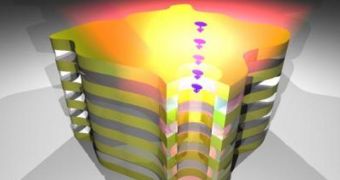An international research effort, made up of scientists from the United Kingdom, Taiwan, and Spain, has recently taken a considerable step forward in furthering the field of photonics research, when it has developed a new, efficient light source for scientific experiments. Photonics is the science of manipulating photons, the basic particles that make up light and other electromagnetic radiation. The innovation is highlighted with a 'Synopsis' in the September 21st issue of the journal Physics.
Using photons to carry information around, especially in next-generation electronics, is one of the main goals of physics today. The recent initiative has managed to create a new light source able to do just that. The instrument is capable of generating infrared light in a compact manner that is sure to advance studies involving these wavelengths in scientific laboratories around the world.
The light source works by firing electrons through a minuscule tunnel in a stack of gold and silica layers, and is also very small and compact. Because it's also tunable, it could constitute a predecessor for new devices placed in optic electronic components. The find is also detailed in the journal Physical Review Letters.
The same two journals also feature a news piece on investigators Nikolay Gromov, Vladimir Kazakov, and Pedro Vieira, who all set to research if unifying particle physics and the string theory was in fact possible, or if it was just a waste of time. The main goal of such a line of research is to eventually find elegant, mathematical formulas that would unite Einstein's theory of gravity and quantum physics. But such a Unified Theory of Everything (UTE) has thus far eluded proof, despite physicists' best efforts.
In 1997, expert Juan Maldacena proposed that the two theories could be united through the introduction of a five-dimensional, space-time rule by string theory. In his approach, the four-dimensional kingdom of a specific quantum theory was only the border of this five-dimensional space. The elegance of his proposals brought Maldacena a large “following,” but scientists were thus far unable to prove this idea completely, as the two initial theories were very different from each other. The three researchers are currently devising some sets of equations that would indeed act as a “toolbox” for future calculations.
The predictions of the string theory could, with the help of these new instruments, be tested against a large number of quantum equations, thus making it easier for theorists to identify any possible correlations between the two. With such an arsenal, perhaps scientists would soon be able to determine if Maldacena's idea is a theory, or just a dream.

 14 DAY TRIAL //
14 DAY TRIAL //